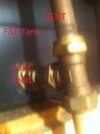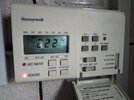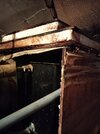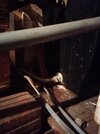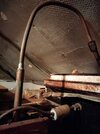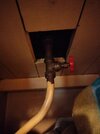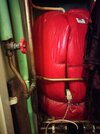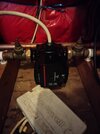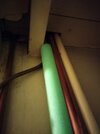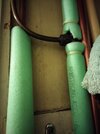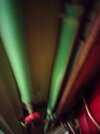Hi,
Just trying to understand our new pump a little more and I'm no expert to say the least on CH matters.
System is open vented with larger cold storage tank and smaller expansion tank in loft. Boiler is Ideal Icos HE18. We have 6 "normal" radiators (3 up, 3 down) plus a towel radiator in the bathroom - so 7 in total. We also have a hot water cylinder in the upstairs airing cupboard and the new Grundfos UPS3 pump is in the same airing cupboard just above the flooring and below the cylinder tank. TRVs on 6 "normal" radiators and the towel radiator is almost fully open on both the inflow and outflow valves. Boiler flow temp for radiators is set at around 50 degrees C (there is no temp setting for hot water). This was also recommended by the central heating team who powerflushed the radiators a few months ago. Prior to that it was around 65-70 degrees C (not exact as the boiler does not have a digital readout - only a numberless dial with min and max - the range of the dial is apparently 30-82 degrees C.) I think we have a two-pipe system. I don't know if we have any "auto bypass valves".
We had the system powerflushed and inhibitor added a few months ago along with TRVs added to the 6 radiators. Engineer did note that our radiators were in very good condition - the existing water in the radiators prior to flushing was quite clean.
Everything is working almost perfectly. We did have the pump replaced, as prior to this, we experienced some random banging noises and hot water going up the vent pipe into the expansion tank and subsequently causing more air in the radiators. The only question I have is what is the best setting for the UPS3 pump. I am by no means familiar with the terminology mentioned in the Grundfos documentation.
There are "constant curve" settings (1,2 and 3).
There are "proportional pressure" settings (low and high)
There are "constant pressure" settings (low and high)
Currently the pump is on "constant curve" 2 - this was the setting chosen by the installer a few weeks ago. We occasionally still get slight expansion of water through the vent pipe in the loft into the expansion tank, but nowhere near like it was with the old pump - so far once per day, but not much water. I'm reluctant to try different speed settings without an understanding or appreciation if they will improve things or not. The pump is quiet and all radiators get warm.
We would love to have zero water expansion into the expansion tank if possible - is that possible, or is it inevitable that some water will always end up in the expansion tank from the vent pipe?
Is it fair to say that if the pump speed is too slow, this will cause boiler to overheat (make some knocking and clanging noises) and then this could cause the water to overflow from the vent pipe into expansion tank and then cause more air in radiators? This seemed to happen when we had the old faulty pump - the return pipe on the boiler was always cold whilst the flow pipe was always hot. The boiler would start making strange noises for a few seconds and then we would get water up the vent pipe.
Any help/advice would be appreciated.
Just trying to understand our new pump a little more and I'm no expert to say the least on CH matters.
System is open vented with larger cold storage tank and smaller expansion tank in loft. Boiler is Ideal Icos HE18. We have 6 "normal" radiators (3 up, 3 down) plus a towel radiator in the bathroom - so 7 in total. We also have a hot water cylinder in the upstairs airing cupboard and the new Grundfos UPS3 pump is in the same airing cupboard just above the flooring and below the cylinder tank. TRVs on 6 "normal" radiators and the towel radiator is almost fully open on both the inflow and outflow valves. Boiler flow temp for radiators is set at around 50 degrees C (there is no temp setting for hot water). This was also recommended by the central heating team who powerflushed the radiators a few months ago. Prior to that it was around 65-70 degrees C (not exact as the boiler does not have a digital readout - only a numberless dial with min and max - the range of the dial is apparently 30-82 degrees C.) I think we have a two-pipe system. I don't know if we have any "auto bypass valves".
We had the system powerflushed and inhibitor added a few months ago along with TRVs added to the 6 radiators. Engineer did note that our radiators were in very good condition - the existing water in the radiators prior to flushing was quite clean.
Everything is working almost perfectly. We did have the pump replaced, as prior to this, we experienced some random banging noises and hot water going up the vent pipe into the expansion tank and subsequently causing more air in the radiators. The only question I have is what is the best setting for the UPS3 pump. I am by no means familiar with the terminology mentioned in the Grundfos documentation.
There are "constant curve" settings (1,2 and 3).
There are "proportional pressure" settings (low and high)
There are "constant pressure" settings (low and high)
Currently the pump is on "constant curve" 2 - this was the setting chosen by the installer a few weeks ago. We occasionally still get slight expansion of water through the vent pipe in the loft into the expansion tank, but nowhere near like it was with the old pump - so far once per day, but not much water. I'm reluctant to try different speed settings without an understanding or appreciation if they will improve things or not. The pump is quiet and all radiators get warm.
We would love to have zero water expansion into the expansion tank if possible - is that possible, or is it inevitable that some water will always end up in the expansion tank from the vent pipe?
Is it fair to say that if the pump speed is too slow, this will cause boiler to overheat (make some knocking and clanging noises) and then this could cause the water to overflow from the vent pipe into expansion tank and then cause more air in radiators? This seemed to happen when we had the old faulty pump - the return pipe on the boiler was always cold whilst the flow pipe was always hot. The boiler would start making strange noises for a few seconds and then we would get water up the vent pipe.
Any help/advice would be appreciated.
Last edited:


